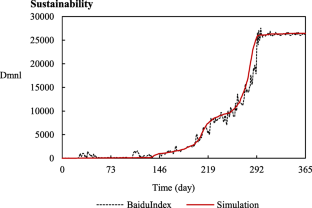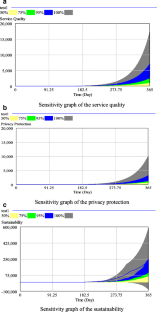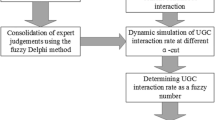Abstract
Constructing the sustainable Online Social Network Marketing Community (OSNMC) is a particularly effective approach to trumpet the products and enhance the customer experience. Super users are considered as opinion leaders, high influence users, and other active users who play a crucial role in enhancing the sustainability of OSNMC. Recruiting sustainable super users is the essential first step to solve unsustainability issues such as the low participation rates and privacy threats problems in the online community. An integrated Fuzzy System Dynamic Model (FSDM) is proposed for selecting suitable super users to build a sustainable OSNMC. FSDM focuses on the super users’ behavioral characteristics of the high-active participation and keen ability to protect privacy. Moreover, the fuzzy analytic hierarchy process method is adopted to obtain the weight of each characteristic, and the growth rate of sustainability is settled with fuzzy Takagi-Sugeno-type fuzzy inference system to address the challenges of the uncertain relationships between super user’s characteristic combinations and the OSNMC sustainability. It does not need line feeds here.
FSDM simulates the fashion marketing community sustainability under super user’s different characteristic combinations in four scenarios. The results show that the OSNMC sustainability needs not only an open and active environment but also privacy control.







Similar content being viewed by others
References
Anonymity (2018) How social communities and social networks differ. Available at: https://www.lithium.com/resources/how-to-guides/how-social-communities-and-social-networks-differ
Gong Z, Liu S (2006) On properties and the corresponding problems of triangular fuzzy number complementary preference relations, International Conference on Fuzzy Systems and Knowledge Discovery. Springer, Berlin, pp 334–343
Hofacker CF, Belanche D (2016) Eight social media challenges for marketing managers. Spanish Journal of Marketing-ESIC 20(2):73–80
Hu H, Han D, Wang X (2010) Individual popularity and activity in online social systems. Physica A: Statistical Mechanics and Its Applications 389(5):1065–1070
Jafarzadeh M, Gans N, Tadesse Y (2018) Control of TCP muscles using Takagi–Sugeno–Kang fuzzy inference system. Mechatronics 2018(53):124–139
John LK, Emrich O, Gupta S et al (2017) Does “liking” lead to loving? The impact of joining a brand’s social network on marketing outcomes. J Mark Res 54(1):144–155
Johnson DS, Lowe B (2015) Emotional support, perceived corporate ownership and skepticism toward out-groups in virtual communities. J Interact Mark 29:1–10
Jussila JJ, Kärkkäinen H, Aramo-Immonen H (2014) Social media utilization in business-to-business relationships of technology industry firms. Comput Hum Behav 30:606–613
Katsamakas E, Georgantzas NC (2007) Open source software development: a systems dynamics model. Proceedings of the 25th International Conference of the System Dynamics Society and 50th Anniversary Celebration, 29
Kim MS, Kim HM (2017) The effect of online fan community attributes on the loyalty and cooperation of fan community members: The moderating role of connect hours. Comput Hum Behav 68:232–243
Kim HS, Mrotek A (2016) A functional and structural diagnosis of online health communities sustainability: A focus on resource richness and site design features. Comput Hum Behav 63:362–372
Kwak H, Lee C, Park H, et al (2010) What is Twitter, a social network or a news media? Proceedings of the 19th international conference on World Wide Web. AcM, 591-600
Li Q, Wang Q, Lin Z (2018) Effects of consumer visit to online community and product channel on local sales of large consumer goods: Evidence from real estate industry. J Strateg Inf Syst 27(2):191–204
Luo N, Zhang M, Hu M et al (2016) How community interactions contribute to harmonious community relationships and customers’ identification in online brand community. Int J Inf Manag 36(5):673–685
Ma N, Liu Y (2014) SuperedgeRank algorithm and its application in identifying opinion leader of online public opinion super network. Expert Syst Appl 41(4):1357–1368
Maar MC (2013) An examination of organizational information protection in the era of social media: A study of social network security and privacy protection. Proquest Llc 2013:359
Malinen S (2015) Understanding user participation in online communities: A systematic literature review of empirical studies. Comput Hum Behav 46:228–238
Mosteller J, Poddar A (2017) To share and protect: Using regulatory focus theory to examine the privacy paradox of consumers' social media engagement and online privacy protection behaviors. J Interact Mark 39:27–38
Orji IJ, Wei S (2015) An innovative integration of fuzzy-logic and systems dynamics in sustainable supplier selection: A case on manufacturing industry. Comput Ind Eng 88:1–12
Otto P, Simon M (2008) Dynamic perspectives on social characteristics and sustainability in online community networks. System Dynamics Review: The Journal of the System Dynamics. Society 24(3):321–347
Pensa RG, Di Blasi G (2017) A privacy self-assessment framework for online social networks. Expert Syst Appl 86:18–31
Ruan Y, Durresi A (2016) A survey of trust management systems for online social communities – Trust modeling, trust inference and attacks. Knowl-Based Syst 106:150–163
Shire MI, Jun GT, Robinson S (2018) The application of system dynamics modelling to system safety improvement: Present use and future potential. Saf Sci 106:104–120
Song K, Wang D, Feng S et al (2012) Detecting positive opinion leader group from forum. International Conference on Web-Age Information Management. Springer, Berlin, pp 95–101
Stelzner MA (2010) Social media marketing industry report. Available at: http://www.socialmediaexaminer.com/social-mediamarketing-industry-report-2010/
Tanimoto J (2016) A multi-community homogeneous small-world network and its fundamental characteristics. Physica A: Statistical Mechanics and its Applications 460:88–97
Van Mierlo T, Voci S, Lee S et al (2012) Super users in social networks for smoking cessation: analysis of demographic characteristics and posting behavior from the Canadian Cancer Society's smokers' helpline online and Stop Smoking Center. Net. J Med Internet Res 14(3):e66
Wasko MML, Faraj S (2000) “It is what one does”: why people participate and help others in electronic communities of practice. J Strateg Inf Syst 9(2-3):155–173
Yang X, Li G (2016) Factors influencing the popularity of customer-generated content in a company-hosted online co-creation community: A social capital perspective. Comput Hum Behav 64:760–768
Yang X, Li G, Huang SS (2017) Perceived online community support, member relations, and commitment: differences between posters and lurkers. Inf Manag 54(2):154–165
Young C (2013) Community management that works: how to build and sustain a thriving online health community. J Med Internet Res 15(6):e119
Zhu DH, Sun H, Chang YP (2016) Effect of social support on customer satisfaction and citizenship behavior in online brand communities: The moderating role of support source. J Retail Consum Serv 31:287–293
Zhu T, Wang B, Wu B et al (2012) Topic correlation and individual influence analysis in online forums. Expert Syst Appl 39(4):4222–4232
Acknowledgements
This work was supported by the Chinese National Natural Science Foundation (No. 71271132,71871135), and by Shanghai Pujiang Program (No.15PJC049).
Author information
Authors and Affiliations
Corresponding author
Additional information
Publisher’s Note
Springer Nature remains neutral with regard to jurisdictional claims in published maps and institutional affiliations.
Appendix
Appendix
Rights and permissions
About this article
Cite this article
Zhang, F., Li, S. & Yu, Z. The super user selection for building a sustainable online social network marketing community. Multimed Tools Appl 78, 14777–14798 (2019). https://doi.org/10.1007/s11042-018-6829-0
Received:
Revised:
Accepted:
Published:
Issue Date:
DOI: https://doi.org/10.1007/s11042-018-6829-0


